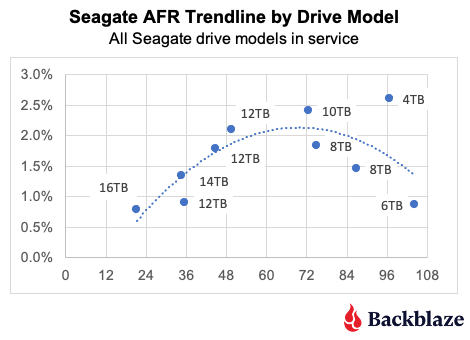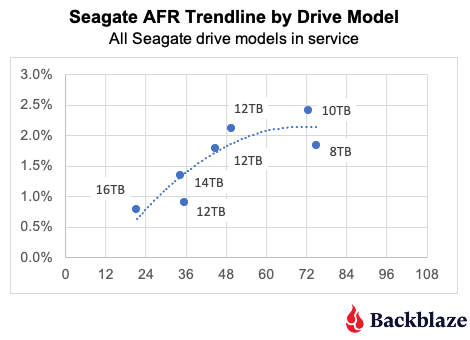
Pensioner hard disks just keep on spinning
Backup firm Backblaze has released its latest annual report on hard disk failure rates – and it appears that some types of hard disk are more durable than first thought.
Backblaze publishes regular reports on the failure rates of hard disks and SSDs in its server farms, which always make interesting reading for those managing storage pools.
It won’t shock anyone that hard disk failure rates trend upwards as drives get older. Annualised failure rates for the 266,007 hard disks in active use at Backblaze increased significantly in 2023, climbing to 1.7% from 1.37% in 2022 and only 1.01% in 2021.
The reason for the increased failure rate? The drives are simply getting older. Yet, it’s encouraging just how long many of the hard disks in Backblaze’s fleet last before spinning their last platter. “There are currently nine drive models with an average age of six years or more,” Backblaze’s Principal Cloud Storage Storyteller (yes, that’s actually his job title) Andy Klein reveals in the report. “The nine models make up nearly 20% of the drives in production.”
Related: Why storage backup is essential in 2024
Hard disks that refuse to die
There are some types of hard disk in Backblaze’s storage pool that don’t fail more often with age, once they’ve reached the age of six years.
Take these Seagate drives, for example:


The graph on the left shows the annualised failure rate for all of the Seagate models in Backblaze’s pool, while the graph on the right excludes models that are more than seven years old.
“Interestingly, the trendline for the two charts is basically the same up to the six-year point,” Klein writes. “If we attempt to project past that for the 8TB and 12TB drives there is no clear direction.”
He adds: “Muddying things up, even more, is the fact that the three models we removed because they are older than seven years are all consumer drive models, while the remaining drive models are all enterprise drive models. Will that make a difference in the failure rates of the enterprise drive model when they get to seven, eight or even nine years of service? Stay tuned.”
The helium effect on hard disk failures
Hitachi Global Storage Technologies (HGST) drives also showed a similar ability to survive once they’d reached maturity, and here Klein wonders if a change in the way the drives are manufactured has increased longevity.
“Beginning with the 8TB drive models, helium was used inside the drives and the drives were sealed,” he writes. “Prior to that they were air-cooled and not sealed. So did switching to helium inside a drive affect the failure profile of the HGST drives? Interesting question, but with the data we have on hand, I’m not sure we can answer it — or that it matters much anymore as helium is here to stay.”
Whatever the reason, it’s perhaps reassuring to know that your hard disks might not be at death’s door, even if they’ve been in active service for six or seven years.
NEXT UP

Panos Skliamis, CEO of SPIN Analytics: “It’s important to see the changes we’re living through in the context of the transformations that have come before”
We interview Panos Skliamis, CEO of SPIN Analytics, an AI-driven platform that automates credit risk management and regulatory compliance

Why hiring for skills future proofs business operations in cyber and tech
For business operations in cyber, hiring based solely on previous experience and formal education is no longer practical, argues Ev Kontsevoy.

Riken to integrate IBM’s quantum system with supercomputer Fugaku
IBM and Japanese laboratory Riken have announced an agreement to deploy IBM’s quantum system and integrate it with supercomputer Fugaku